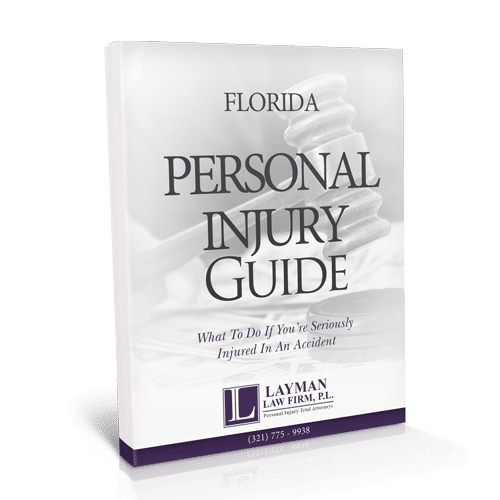Melbourne Eye Injury Lawyers
Head and eye injuries can be frightening and painful. They also frequently result in permanent damage that requires intensive ongoing treatment. If another party caused or contributed to your head and eye injury, you may be entitled to compensation to cover the medical bills, lost wages, and other financial consequences of the injury. You may also be entitled to compensation for the pain, suffering, disfigurement, and other subjective damages incurred as a result of the defendant’s negligent or wrongful conduct.
The experienced Melbourne eye injury lawyers at Layman Law Firm, P.L. have seen first-hand the devastating impact of head and eye injuries. Our extensive experience, considerable resources, and unwavering commitment will be used to make sure the responsible party (or parties) is held accountable and zealously pursue full and fair compensation for the injuries you have suffered.
What Is a Head and Eye Injury?
The human head is unlike any other in nature. People often focus on the risk of a traumatic brain injury when a head injury occurs; however, the risk of a debilitating eye injury is equally likely. The human eye is a complex organ with dozens of sensitive interrelated parts. Each of those parts is critical to allowing us to see clearly, perceive depth, and experience the world in the array of colors to which we are accustomed. When the human eye sustains damage because of a head injury, it can cause lasting damage that may include impaired vision, headaches, balance problems, loss of depth perception, or total blindness in one or both eyes. Moreover, the intricate nature of the human eye often makes it extremely difficult, if not impossible, to fully repair the damage when the eye is injured.
How Do Head and Eye Injuries Happen?
Head and eye injuries can occur under a variety of circumstances, such as workplace injuries, sports injuries, medical errors, and motor vehicle crashes. According to the Centers for Disease Control and Prevention (CDC), about 2000 U.S. workers sustain a job-related eye injury that requires medical treatment every day. The most common types of eye injuries include:
- Striking or scraping injuries. Eye injuries can be caused by small particles striking or scraping the eye, such as dust, cement chips, metal slivers, and wood chips which are common on a worksite.
- Penetration injuries. Glass, nails, staples, or wood/metal slivers can penetrate the eyeball while in the workplace or because of a car accident, causing partial or full loss of vision.
- Surface hemorrhage injuries. An eye surface hemorrhage (bleeding) can be caused by trauma to the eye. A subconjunctival hemorrhage happens when blood appears in the clear skin part of the eye (the conjunctiva) that covers the white part (the sclera). Blood can also pool between the cornea and the iris (the clear transparent part of the eye and the colored part).
- Chemical and thermal burn injuries. Chemical burn injuries to the eye can happen when industrial chemicals or cleaning products get in or near the eye. Thermal (heat) burns, caused by blow torches and other high heat tools, can also result in serious eye injuries.
- Orbital fracture injuries. Blunt force trauma occurring during a sports injury, in a car accident, or on a worksite can lead to broken bones in the orbital floor or medial wall. Bruising, swelling, double vision, and tissue or muscle entrapment in the fractured bone can occur as a result of the fracture.
- Retinal detachment. Trauma to the eye can cause the retina (thin tissue on the back of the eye) to detach, or pull away, from the wall of the eye. This can cause permanent loss of vision.
- Surgical errors. Eye surgery to correct or improve vision is now commonplace. Sometimes, however, a preventable error occurs during the surgery that causes further injury to the eye or the surrounding muscles, ligaments, or bones. This could include things such as a severed nerve, a fractured bone, or dangerous bruising and swelling around the eye socket.
What Are Some Common Symptoms of an Eye Injury?
Head injuries may not produce obvious symptoms for hours, even days, after the injury. The same is true for eye injuries. Given the delicate and complex nature of the human eye, the window of opportunity for preventing further damage and/or repairing injury to the eye is often rather short. Furthermore, the symptoms of an eye injury often worsen over time. Both make it important to have a thorough medical examination done immediately following a head or eye injury. Symptoms you might experience following an eye injury include:
- Blood in the eye
- Pain and swelling
- Blurred vision
- Change in the ability to move the eye
- Dizziness and/or vertigo
- Loss of balance
- Partial or full loss of your sight
- Reduced ability to see in the dark
- Change in depth perception
- Loss of peripheral vision
- Double vision
- Sensitivity to light
How Are Eye Injuries Treated?
Both the type of treatment available and the long-term prognosis for an eye injury will depend on the cause and severity of the injury. While minor eye injuries require relatively simple treatment, such as ice, anti-inflammatory medications, and resting the eye, more serious eye injuries require complex surgery that may not restore the eye to its previous level of function and acuity. When that is the case, the injured victim may live with partial or total loss of vision for the rest of his/her life.
Am I Entitled to Compensation for My Melbourne Head or Eye Injury?
Head and eye injuries are often the result of negligence or wrongful conduct on the part of another party. For example, another driver’s negligence may have caused or contributed to a collision in which you suffered an eye injury. Other examples of negligent or wrongful conduct that might have contributed to an eye injury include things such as a preventable surgical error, intentional physical assault, or an unsafe workplace.
When negligence or wrongful conduct causes, in whole or in part, a victim’s injuries, the victim may be entitled to compensation for the economic and non-economic damages suffered because of that negligence. Economic damages are intended to compensate a victim for objective, easily proven, damages, including things such as:
- Medical expenses, including doctor, hospital, and therapist expenses
- Rehabilitation, in-home care, and long-term care costs
- Lost income or loss of earning capacity
- Specialized medical equipment
Non-economic damages compensate an injured victim for the subjective damages caused by the defendant’s negligence, such as:
- Pain and suffering
- Emotional distress
- Loss of enjoyment of life
- Disfigurement
- Mental anguish
- Loss of consortium
Contact the Experienced Melbourne Eye Injury Lawyers at Layman Law Firm, P.L.
If you believe that someone else’s negligent or wrongful conduct caused or contributed to your head or eye injury, contact the experienced and compassionate Melbourne head and eye injury lawyers at Layman Law Firm, P.L. to discuss your legal options. Contact the team today for your free initial consultation by calling 321-773-2111 or by filling out our convenient Intake Evaluation Form online.






